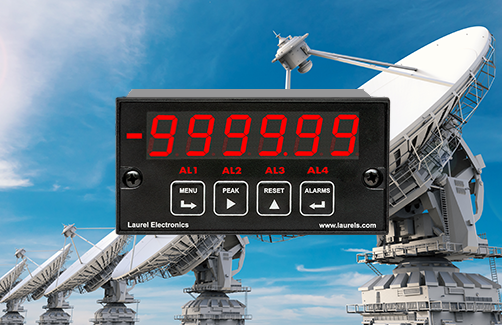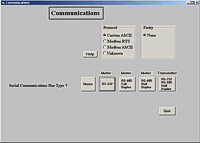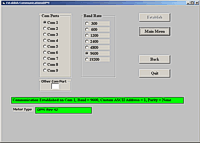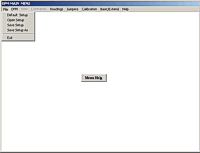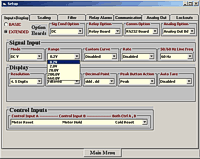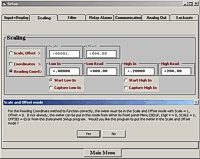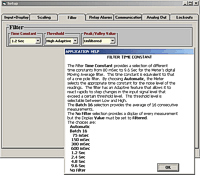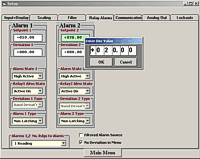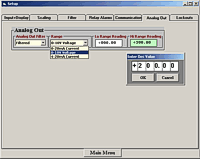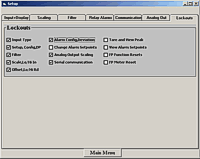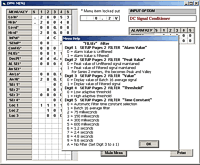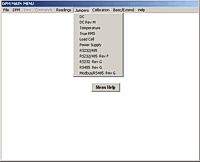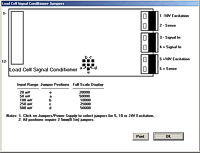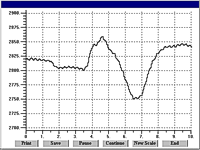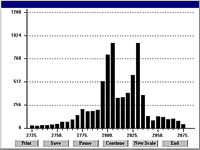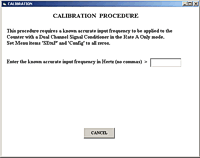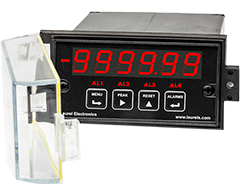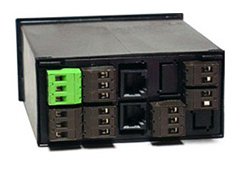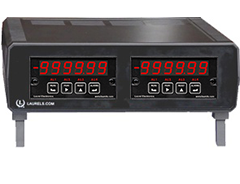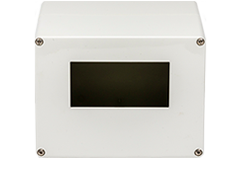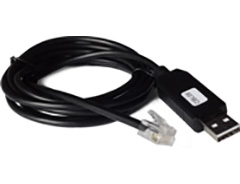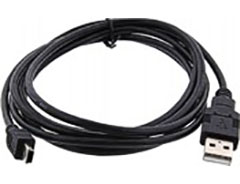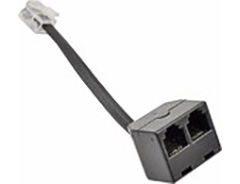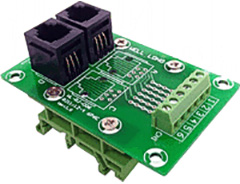Features
- Accepts low-level differential or single-ended 5V logic level signals from shaft encoders, linear encoders, incremental encoders or optical encoders
- 6-digit scalable display for position, length or rate
- Programmable for position, angle or rate
- Maximum pulse rates of 250 kpulses/sec at X1, 125 kpulses/sec at X2, 62.5 kpulses/sec at X4
- Display update rate up to 25/s
- Zero channel input
- Digital span adjust from 0 to ±999,999, zero adjust from -999,999 to +999,999
- Front panel scalable: to ±999,999 for use with current shunts
- 1/8 DIN size with bright red or green 0.56" (14.2mm), high LED digits
- Transducer excitation output, 5, 10, 12, or 24 Vdc (isolated)
- Power 85-264 Vac / 90-300 Vdc or 10-48 Vdc / 12-32 Vac (isolated)
- Operating temperature from -40°C to 70°C (-40°F to 158°F)
- Wide choice of Plug-in-Play options:
- 2 or 4 relays, mechanical or solid state, for alarm or control (isolated)
- 1 or 2 Analog output, 4-20 mA, 0-20 mA, 0-10V, or -10V to +10V (isolated)
- Communications: Ethernet, WiFi, USB, RS232, RS485 (isolated)
- Extended DPM includes set up for scaled position or rate, but not forsimultaneous position and rate
The Laureate™ 1/8 DIN Digital Panel Meter for bidirectional position, length or angle measurement
with the Standard counter main board accepts the A & B quadrature signals from shaft encoders or linear encoders to provide a highly accurate, scaled display of position, length, or angle in engineering units, such as ft, cm or degrees. The A & B quadrature signals are 90° out of phase, and their phase relationship determines whether up counts (+) or down counts (-) are counted. The meter totalizes the counts and then scales the total in software for display and control. A zero index signal, or Z signal, can be added as a third input to the A & B signals.Bidirectional Rate Measurement
The Laureate™ quadrature meter with the Extended counter main board can be set up for scaled position or rate, but not for simultaneous position and rate. For example, it can display the speed of a moving slab in ft/sec. The display and control output update rate for position or rate is normally set to a maximum of 25/sec, as determined by a user-programmable gate time.
Quadrature Meter Capabilities
- One, two or four quadrature transitions may be counted at a maximum combined rate of 250 kHz and be mathematically scaled for display in engineering units from -999,999 to +999,999. Maximum pulse rates are 250 kpulses/sec at X1, 125 kpulses/sec at X2, and 62.5 kpulses/sec at X4.
- Single-ended input signals up to 5V or balanced line driver signals up to 10V are accommodated by the quadrature signal conditioner board. Anti-jitter circuitry eliminates errors due to vibration of the encoder.
- An excitation output from the meter can be used to power the encoder, thus avoiding the need for an external powr supply. Jumper selectable levels are 100 mA at 5V or 120 mA at 10V.
- A zero index pulse, if available from the encoder, is interpreted by the meter as a zero reference for an integral number of revolutions of a rotary encoder, or as the home position of a linear encoder. It is used by the meter for initializing and correcting any cumulative pulse count errors. Special circuitry corrects for width of the zero index pulse.
- In the event of a power failure, the latest total can be stored in non-volatile memory and be used as the starting point for counting when power resumes. Power fail save or zero index capabilities are alternate meter setup choices.
Unidirectional Position and Rate
If the counts are only for one direction, for example for extrusions measured by an encoder wheel, only the encoder's "A" channel can be used and be output to an Extended Laureate totalizer. This model accommodates very high pulse rates up to 1 MHz, and unlike the quadrature meter, it can simultaneously track rate and total. It can also be programmed for batch control, which allows it to simultaneously track rate, batch (or current) total, and grand total or number of batches.
Laureate Digital Panel Meters are easily programmed with Laurel’s free Instrument Setup Software, downloadable from our website and compatible with Windows PCs, requiring a data interface board for setup.
All signal conditioner board ranges are factory-calibrated, with calibration factors for each range securely stored in an onboard EEPROM. These factors can be scaled via software to accommodate external shunts, enabling field replacement of signal conditioner boards without necessitating recalibration of the associated digital panel meter. For optimal accuracy, factory recalibration is recommended annually. All Laurel Electronics instruments undergo factory calibration using the industry-leading Fluke calibrators, which are recalibrated yearly and certified traceable to national standards, ensuring the highest level of precision and reliability.
Digital signal filtering modes can be selected to ensure stable readings in electrically noisy environments.
- An unfiltered selection provides true peak and valley readings and aids in control applications.
- A batch average filter selection averages each 16 conversions.
- An adaptive moving average filter selection provides a choice of 8 time constants from 80 ms to 9.6 seconds. When a significant change in signal level occurs, the filter adapts by briefly switching to the shortest time to follow the change, then reverts back to its selected time constant. An Auto setting selects the time constant selection based on signal noise.
Peak and valley values are automatically captured. These may be displayed via a front panel pushbutton command or control signal at the rear connector, or be transmitted as serial data.
Two rear panel control Inputs (CMOS/TTL levels, logic 0 = tied to digital ground, logic 1 = open) or dry contacts that can be set to control / activate 14 meter commands.
An (isolated) 5, 10, 12, or 24 Vdc excitation output is standard to power transducers or two-wire transmitters. Ratiometric operation, which automatically compensates for changes in the applied excitation, is jumper selectable for applications, such as bridges, where the signal to be measured is proportional to the excitation level.
Modular Design for Maximum Flexibility at Minimum Cost
All boards are isolated from meter and power grounds. Optional Plug-in-Play boards for communications and control include Ethernet, WiFi, serial communication boards, dual or quad relay boards, and an analog output board. Laureates may be powered from 85-264 Vac or optionally from 12-32 Vac or 10-48 Vdc. The display is available with bright red or green 0.56" (14.2mm) high LED digits. The 1/8 DIN case meets NEMA 4X (IP65) specifications from the front when panel mounted. Any setup functions and front panel keys can be locked out for simplified usage and security. A built-in 5, 10, 12, or 24 Vdc excitation supply can power transducers, eliminating the need for an external power supply. All power and signal connections are via UL / VDE / CSA rated screw clamp plugs.
The Laureate™ Series features modular design with up to 7 isolated plug-in boards, applicable to all Laureate 1/8 DIN Digital Panel Meters.

Modular Hardware
The design of the Laureate™ Series is modular for maximum flexibility at minimum cost. All boards are isolated from meter and power grounds. The base configuration for a panel meter or counter consists of a main module (with computer and plug-in display boards), a power supply board, and a signal conditioner board. Optional plug-in-play boards include an isolated setpoint controller board, an isolated analog output board, and an isolated digital interface board. Modular design and a choice of plug-in options allow the Laureate to be customized for a broad range of applications from simple monitoring to control and computer interface. There can be up to five plug-in boards in a 1/8 DIN Laureate.

Connecting Laureate Digital Panel Meters to a Local Area Network (LAN)
Up to 30 Laureate Digital Panel Meters and/or LT Transmitters can be configured for RS485 and daisy-chained to an LT Transmitter using Laurel’s High Speed Ethernet-to-RS485 converter board for seamless LAN integration. Alternatively, Laurel LTE series Ethernet transmitters can connect directly to a LAN via an Ethernet cable. Setup for both configurations is streamlined using Laurel’s free Instrument Setup Software, which simplifies node discovery and transmitter configuration.
Flexible Communication Options for Digital Panel Meters
Laureate Digital Panel Meters can be equipped with Laurel communication boards to support various interfaces and protocols. These include serial interfaces with ASCII or Modbus RTU protocols, and Ethernet interfaces with web access, ASCII, or Modbus TCP/IP protocols, ensuring versatile connectivity for your commercial applications.

| Display | |
|---|---|
| Readout | 6 LED digits, 7-segment, 14.2 mm (.56"), red or green. |
| Display Range | -999,999 to +999,999, XXXXEX notation beyond 999,999 |
| Zero Adjust | -999,999 to +999,999 |
| Span Adjust | 0 to ±999,999 |
| Indicators | Four LED lamps |
| Inputs | |
| Types | Differential or single-ended quadrature |
| Transitions Monitored | X1, X2 or X4 |
| Max Pulse Rate | 250 kpulses/sec at X1, 125 kpulses/sec X2, 62.5 kpulses/sec at X4 |
| Position Error | No error contributed by meter |
| Differential High Threshold | +200 mV |
| Differential Low Threshold | -200 mV |
| Differential Limits | -11V to +14V |
| Single-ended High Voltage | 2.5V to 10V |
| Single-ended Low Voltage | -1V to +1V |
| Input Resistance, Typ. | 17 kOhm |
| Recalibration: All ranges are calibrated at the factory. Recalibration is recommended every 12 months. | |
| Quadrature Position Mode | |
| Zero Adjust | -999,999 to +999,999 |
| Span Adjust | 0 to ±999,999 |
| Quadrature Rate Mode | |
| Freq. Technique | Inverse period |
| Conversion Time | Gate time + 30 ms + 0-2 signal periods |
| Gate Time | Selectable 10 ms to 199.99 s |
| Time Before Zero Out | Selectable 10 ms to 199.99 s |
| Output & Display Update | Same as conversion time |
| Time Base Accuracy | Calibrated to ±2 ppm |
| Power Supply Boards (one required) | |
| Voltage, standard | 85-264 Vac or 90-300 Vdc |
| Voltage, optional | 12-32 Vac or 10-48 Vdc |
| Frequency | DC or 47-63 Hz |
| Power Consumption (typical, base meter) | 1.2W @ 120 Vac, 1.5W @ 240 Vac, 1.3W @ 10 Vdc, 1.4W @ 20 Vdc, 1.55W @ 30 Vdc, 1.8W @ 40 Vdc, 2.15W @ 48 Vdc |
| Power Isolation | 250V rms working, 2.3 kV rms per 1 min test |
| Excitation Output (standard) | |
| 5 Vdc | 5 Vdc ± 5%, 100 mA (jumper selectable) |
| 10 Vdc | 10 Vdc ± 5%, 120 mA (jumper selectable) |
| 12 Vdc | 12 Vdc ± 5%, 100 mA (jumper selectable) |
| 24 Vdc | 24 Vdc ± 5%, 50 mA (jumper selectable) |
| Output Isolation | 50 Vdc from signal ground |
| Analog Output Boards (one optional) | |
| Output levels | 4-20 mA, 0-20 mA, 0-10V, -10 to +10V (single-output option) |
| Current compliance | 2 mA at 10V ( > 5 kΩ load) |
| Voltage compliance | 12V at 20 mA (< 600 Ω load) |
| Scaling | Zero and full scale adjustable from -99999 to +99999 |
| Resolution | 16 bits (0.0015% of full scale) |
| Isolation | 250V rms working, 2.3 kV rms per 1 min test |
| (dual analog outputs share the same ground) | |
| Relay Output Boards (one optional) | |
| Dual magnetic relays | 2 Form C, 10A max, 440Vac or 125Vdc max, 2500VA or 300W |
| Quad magnetic relays | 4 Form A (NO), 10A max, 440Vac or 125Vdc max, 2500VA or 300W |
| Dual solid state relays | 2 Form A (NO), AC or DC, 0V - 400V, 120Ma, 35Ohms (max at On-State) |
| Quad solid state relays | 4 Form A (NO), AC or DC, 0V - 400V, 120Ma, 35Ohms (max at On-State) |
| Relay commons | Isolated commons for dual relays or each pair of quad relays |
| Relay isolation | 250V rms working, 2.3 kV rms per 1 minute test |
| Relay latching modes | Latching or non-latching |
| Relay active modes | Active on or off, active high or low |
| Hysteresis modes | QA passband mode, split hysteresis, span hysteresis |
| Communication Boards (one optional) | |
| Board selections | RS232, RS485 with dual RJ11 connectors, RS485 with dual RJ45 connectors, USB, Ethernet, USB-to-RS485 gateway, Ethernet-to-RS485 gateway, WiFi with built-in antenna plus USB & RS485, WiFi with external antenna plus USB & RS485 |
| Protocols | Laurel Custom ASCII (serial), Modbus RTU (serial), Modbus TCP (Ethernet or WiFi) |
| Digital addresses | 247 (Modbus), 31 (Laurel ASCII), |
| Isolation | 250V rms working, 2.3 kV rms per 1 min test |
| Environmental | |
| Operating temperature | -40°C to 70°C (-40°F to 158°F) |
| Storage temperature. | -40°C to 85°C (-40°F to 185°F) |
| Relative humidity | 95% at 40°C, non-condensing |
| Protection | NEMA-4X (IP-65) when panel mounted |
| Mechanical | |
| Enclosure | 1/8 DIN, high impact plastic, UL 94V-0, color: black |
| Mounting | 1/8 DIN panel cutout required: 3.622" x 1.772" (92 mm x 45 mm). |
| Dimensions | 4.68" x 2.45" x 5.64" (119 mm x 62 mm x 143 mm) (W x H x D) |
| Maximum panel thickness | 4.5 mm (0.18") |
| Tightening Torque - Connectors | Screw terminal connectors: 5 lb-in (0.56 Nm) |
| Tightening Torque - Pawls | Digital Panel Meter Case Pawls: 5 lb-in (0.56 Nm) |
| Weight of base meter | 210 g (7.4 oz) typical (DPM, counter, timer, 6-digit remote display) |
| Weight of option boards | 30 g (1.0 oz) typical per board (analog output, relay output, communications) |
| General | |
| Programming Methods | Four front panel buttons or via Laurel's free Instrument Setup Software, which runs on a PC under MS Windows. |
| Security | Lockout options include using the front panel buttons, the free Instrument Setup Software, or a hardware jumper. |
| Warranty | 3 years parts & labor |
| Recalibration: All ranges are calibrated at the factory. Recalibration is recommended every 12 months. | |
Free Instrument Setup Software for Series 2 Laureates
Free Downloadable Windows-based Instrument Setup (IS) software (Data Interface Board Required) for use with our programmable Digital Panel Meters, Scale Meters, Counters, Timers, Remote Displays, and Transmitters, are an easy method to set up Laureate 1/8 DIN digital panel meters, counters, timers, remote displays, and DIN-rail transmitters, as explained in the Instrument Setup Software Manual. Laureate 1/8 DIN instruments can also be set up from the front panel, as explained in their respective Owners Manuals. Instrument Setup software is of benefit whether or not the PC is connected to the instrument.
- When the PC is connected to the instrument, Instrument Setup software can retrieve the setup file from the instrument or open a default setup file or previously saved setup file from disk View Setup, then provides graphical user interface (GUI) screens with pull-down menus applicable to input, display, scaling, filtering, alarms, communications, analog output, and front panel lockouts. Fields that are not applicable to the instrument as configured are either left out or grayed out. Clicking on any item will bring up a detailed Help screen for that item. After editing, the setup file can be downloaded, uploaded to the instrument, or saved to a disk. The same setup file can then be downloaded into multiple instruments.
- When the PC is not connected to the instrument, the above GUI screens can be used to set up a virtual instrument. The setup file can then be saved to disk. Switching toView Menu then brings up a screen with the required front panel programming steps. This view can be printed out for use at the instrument site and to serve as a hard copy record.
Download Free Instrument Setup Software
Installation
Set User Account Control (UAC) of MS Windows to "Never notifiy me" so that Instrument Setup Software can create directories. The UAC change screen can be reached as follows:
- Under Windows 7, click on the Windows Start button in the lower left of the desktop and enter "UAC" in the search field.
- Under Windows 8, navigate to Control Panel, then to the "User Accounts and Family Safety" section, and click on "Change User Account Control Settings."
- Under Windows 10, click on the Windows Start button in the lower left of the desktop, then on "Settings", and enter "UAC" in the search field.
- Reboot your computer for the changed UAC setting to take effect.

RJ11-to-DB9 cable with rear view of DB9 connector to PC

RS232 cable, meter to PC, P/N CBL01
Laureate 1/8 DIN Laureate instruments must be equipped with a serial communications board and be connected to the computer via a serial communications cable. The connection can be via RS232, RS485, USB or Ethernet. Following setup, the serial communications board may be removed from the instrument if desired. The wiring of the RS232 cable is illustrated above with end views of the two connectors.
Laureate LT Series transmitters come standard with a 3-wire serial interface, which can be jumpered for RS232 or RS485.
Laureate LTE Series transmitters come standard with an Ethernet interface.
Meter Setup Screens
Click on any of the reduced screens below for a full-size screen view, then click on the Back button of your browser to return to this page. The screens examples below are for a fully-loaded Series 2 Digital Panel Meter (DPM), which is connected to the PC via RS232. If the meter is a Series 1 meter (pre-2007), this is sensed by the software, and somewhat different screens are brought up. Please see Series 1 setup screens.











Meter Setup Utilities




From the Main Menu, click on Readings if your PC is connected to the meter. A pull-down menu then offers three choices: List, Plot and Graph.
- List presents the latest readings in a 20-row by 10-column table. Press Pause at any time to freeze the display. This is one method to capture peak readings.
- Plot generates a plot of readings vs. time in seconds. It effectively turns the DPM-PC combination into a printing digital oscilloscope.

- Graph generates a histogram where the horizontal axis is the reading and the vertical axis is the number of occurrences of readings. The display continually resizes itself as the number of readings increases.



Laureate™ 1/8 DIN Case For Laureate Digital Panel Meters, Counters, Timers & Remote Displays

Key Features
- Meets 1/8 DIN Standard.
- Installs from front of panel.
- Short depth behind the panel: only 4" (102 mm) plus connectors.
- Understated 0.157" (4 mm) thick bezel.
- Meets NEMA 4X (IP-65) for high-pressure wawshdon when panel mounted.
- Screw clamps connectors meet VDE / IEC / UL / CSA safety standards.
- Rugged GE Lexan® housing material.
- Safety certified per EN 61010-1.
Dimensions

Maximum panel thickness: 4.5 mm (0.18")
Weight of base meter: 210 g (7.4 oz) typical (DPM, counter, timer, 6-digit remote display)
Weight of option boards: 30 g (1.0 oz) typical per board (analog output, relay output, communications)
Tightening Torque - Connectors: Screw terminal connectors: 5 lb-in (0.56 Nm)
Tightening Torque - Pawls: Digital Panel Meter Case Pawls: 5 lb-in (0.56 Nm)
Dimensioned CAD assembly drawings in EPRT, STEP, x_t. dwg, pdf file formats: Laureate-meter-case.zip (zipping prevents browser from opening CAD files as text files).
Panel Mounting
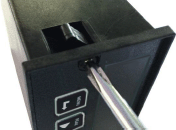 Slide the meter into a 45 x 92 mm 1/8 DIN panel cutout. Ensure that the provided gasket is in place between the front of the panel and the back of the meter bezel.
The meter is secured by two pawls, each held by a screw, as illustrated. Turning each screw counterclockwise extends the pawl outward from the case and behind the panel. Turning each screw clockwise further tightens it against the panel to secure the meter.
Slide the meter into a 45 x 92 mm 1/8 DIN panel cutout. Ensure that the provided gasket is in place between the front of the panel and the back of the meter bezel.
The meter is secured by two pawls, each held by a screw, as illustrated. Turning each screw counterclockwise extends the pawl outward from the case and behind the panel. Turning each screw clockwise further tightens it against the panel to secure the meter.
Turning each screw counterclockwise loosens the pawl and retracts it into its well. This position allows installed meter to be removed from their panel, or new meters to be installed in a panel. Do not remove the screws from their pawls. Doing so would cause the screw and pawl to fall off and likely get lost. Do not overtighten so as not to damage the plastic parts.
| Using Quadrature for Cutting to Length | |
|---|---|
 |
Controlling the repetitive cutting of material to length is an excellent application of the Laureate quadrature meter. The quadrature encoder shares the shaft of a sensing wheel, whose rotation corresponds to lineal displacement of material. The meter compares the displacement reading against setpoint information, and then uses its dual relays to first slow down and then cut the material. |
| Using Quadrature for X-Y Positioning | |
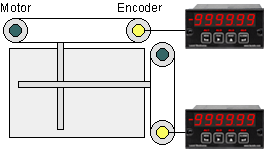 |
Accurate X-Y position or rate can be obtained from two shaft encoders, which convert linear position to quadrature signals as a shaft turns. In addition to serving as a display, each Laureate can use its optional dual relay setpoint capability for closed loop control. It can also transmit data via RS232, RS485, or a 4-20 mA analog signal. |
| Using Quadrature to Monitor a Drilling Operation | |
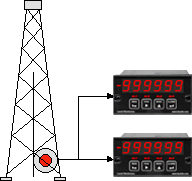 |
Quadrature can be used to track position and vertical drilling speed of the bit in an oil drilling operation. A shaft encoder is rotated by a cable that moves with the drilling shaft. In this application, the same encoder signal is applied to a Laureate quadrature meter for position, and to a second quadrature meter for rate. Both meters can be scaled to read out in appropriate engineering units, such as feet and inches per minute, and can be alarmed. A Laureate 6-digit remote display could be added to read out peak rate. |
IPC
Splashproof Cover
CLB01
RS232 Cable for Meters
CLB02
USB-to-RS232 Adapter Cable
CBL04
RS232 Cable for LT Transmitters
CLB05
USB Data Cable for Meters
CLB06
USB-to-RS485 Adapter Cable
CLB07
USB Programming & Data Cable
CLB08
RS485 Splitter Cable
BKBD
RS485 RJ11 Terminal Block Adapter
Understanding the 1/8 DIN Panel Meter for Quadrature Encoder Input and Bidirectional Position or Rate
A 1/8 DIN Panel Meter for Quadrature Encoder Input and Bidirectional Position or Rate measurement is a precision instrument designed for industrial and automation applications. It provides accurate monitoring and display of position, speed, or rate of movement in systems utilizing quadrature encoders. This section explores the functionality, features, and applications of this specialized device.
1. What is a 1/8 DIN Panel Meter?
The term DIN stands for Deutsches Institut für Normung, the German Institute for Standardization, which defines global standards for industrial device dimensions. A 1/8 DIN Panel Meter has a front panel size of approximately 96mm x 48mm (3.78" x 1.89"), making it compact and ideal for space-constrained control panels.
A Panel Meter is an electronic device that displays input signals in a digital format, monitoring parameters such as voltage, current, temperature, or, in this case, position or rate from a quadrature encoder. Its digital readout ensures precise, easy-to-read measurements critical for industrial control and automation.
2. Quadrature Encoder Input
A quadrature encoder is an incremental encoder that measures the position and direction of a rotating shaft, generating two output signals (A and B) that are 90 degrees out of phase. These signals allow the determination of rotational direction (clockwise or counterclockwise) and precise position tracking.
The Quadrature Encoder Input capability of this Panel Meter enables it to decode these signals, accurately calculating the position or rate of movement. This is essential for applications requiring precise motion control, such as CNC machines, robotic systems, and conveyor operations.
3. Bidirectional Position or Rate Measurement
The Bidirectional Position feature allows the Panel Meter to track movement in both forward and reverse directions, critical for applications with non-unidirectional motion. Similarly, Bidirectional Rate Measurement enables monitoring of speed in both directions, vital for precise control in systems like motor drives or conveyors.
4. How Does a 1/8 DIN Panel Meter Work?
The operation of this Panel Meter involves several key steps:
-
Signal Acquisition: The meter receives A and B pulse signals from a quadrature encoder connected to a rotating shaft or moving component.
-
Signal Processing: Internal electronics decode the phase relationship between A and B signals to determine direction and count pulses for position or rate calculations.
-
Digital Conversion: The processed data is converted into digital values, representing position (e.g., distance or angle) or rate (e.g., speed in RPM).
-
Display and Output: Results are displayed on a clear digital screen, with options for alarms, relays, or communication interfaces (e.g., RS-485) for integration with control systems.
5. Key Features and Benefits
This 1/8 DIN Panel Meter offers several features that enhance its utility:
- High Accuracy: Delivers precise measurements of position and rate for reliable control.
- Versatility: Compatible with various quadrature encoders, adapting to diverse applications.
- Bidirectional Measurement: Tracks movement and speed in both directions for comprehensive monitoring.
- Compact Size: The 1/8 DIN size fits easily into space-constrained control panels.
- Easy Integration: Seamlessly integrates with existing systems, supporting analog and digital outputs.
Applications
This Panel Meter is widely used in industries requiring precise motion control, including:
- CNC Machines: Ensuring accurate positioning for cutting and shaping materials.
- Robotics: Monitoring position and speed for precise robotic movements.
- Conveyor Systems: Tracking position and speed for efficient material handling.
- Motor Control: Regulating speed and direction in industrial machinery.
Conclusion
A 1/8 DIN Panel Meter for Quadrature Encoder Input and Bidirectional Position or Rate is a critical tool for precise motion monitoring and control in industrial applications. Its ability to process bidirectional inputs and provide accurate digital readouts makes it an essential component in modern automation systems, ensuring efficiency and reliability.
Where Is a 1/8 DIN Panel Meter for Quadrature Encoder Input and Bidirectional Position or Rate Used?
A 1/8 DIN Panel Meter designed for quadrature encoder input and bidirectional position or rate measurement is a specialized instrument critical for precise motion and position control across various industries. Its compact design and high accuracy make it indispensable for applications requiring real-time feedback. Below are the primary industries and use cases where this device is deployed.
1. Industrial Automation
In industrial automation, precision in monitoring and controlling machinery is essential. This Panel Meter tracks position and speed in automated systems, providing real-time data for accurate adjustments. Applications include:
- CNC Machines: Monitoring tool positioning for precise material cutting and shaping.
- Robotics: Tracking the movement and orientation of robotic arms for repeatable, accurate operations.
- Assembly Lines: Ensuring precise component positioning to reduce defects and enhance efficiency.
2. Motion Control Systems
Motion control systems in manufacturing and automotive industries rely on quadrature encoders for accurate feedback. This Panel Meter converts encoder signals into readable position or rate data, supporting:
- Servo Motors: Controlling position and speed for precise machinery operation.
- Conveyor Systems: Monitoring speed and position for synchronized material handling.
- Packaging Machines: Ensuring accurate positioning for wrapping, labeling, or sealing processes.
3. Chemical and Pharmaceutical Industries
In chemical and pharmaceutical process control, precise measurement of equipment position and speed is vital for quality and consistency. This Panel Meter provides accurate feedback for:
- Dosing Systems: Monitoring pump positions to ensure precise chemical or ingredient delivery.
- Mixing and Blending: Controlling mixer speed and position for uniform product quality.
4. Renewable Energy Sector
In renewable energy systems, such as wind and solar power, this Panel Meter optimizes component positioning for maximum energy capture. Applications include:
- Solar Tracking Systems: Adjusting solar panel positions to track the sun for optimal energy collection.
- Wind Turbines: Monitoring blade angles to maximize energy output under varying wind conditions.
5. Test and Measurement
In laboratory and testing environments, this Panel Meter ensures accurate position and speed measurements for reliable results. Applications include:
- Material Testing Machines: Tracking testing head positions during tensile, compression, or fatigue tests.
- Environmental Chambers: Controlling sample positioning for consistent testing conditions.
Conclusion
The 1/8 DIN Panel Meter for quadrature encoder input and bidirectional position or rate measurement is a versatile tool essential for precise motion control across multiple industries. From industrial automation and motion control to renewable energy and research, its ability to deliver accurate, real-time data ensures operational efficiency and reliability. As technology advances, the applications for this Panel Meter will continue to grow, solidifying its role in modern industrial and automation systems.
Less Information.








